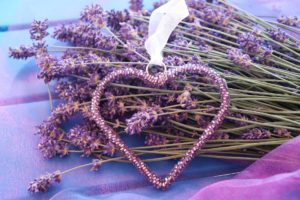We can only imagine what it was like to walk through a field of lavender 5,000 years ago. Human senses were so much more aware of what nature was offering us back then. Nothing interfered with their connection to the beauty within nature so it’s safe they had euphoric feelings that connected their bodies to their spirit.
We don’t have to imagine what lavender was used for 2,500 years ago. There are records that explain what the Phoenicians and Egyptians thought of lavender oil. Those cultures used it for everything, and when Cleopatra was enjoying her time on earth, she chose lavender to seduce Marc Antony.

Lavender wasn’t only useful for seduction. This incredible plant was dried and put in pipes to enhance the flavor of smoking other herbs, and it was steam distilled into oil so the body could be drenched in its aromatic elegance. Lavender could also change itself into an insect repellant, and it was scattered over stone floors to disinfect and deodorize.
A Roman bath was not a true bath unless lavender scented the water. The name lavender comes from the Latin word Lavare, which means ‘to wash.’ The Greeks as well as the Romans flavored their favorite recipes with it, and it was one of the essential herbs grown in the medicinal gardens to fight diseases.
Renaissance Europeans Loved Lavender For Its Medicinal Value
Europeans depended on lavender when the Great Plague of London brought the Black Death to thousands of unsuspecting people. Leather was scented with lavender to help prevent the plague, and bunches of lavender were fastened around the wrists to protect the body from this death sentence.
A concoction called ‘Four Thieves Vinegar” was made from lavender around the same time. Grave robbers used the potion to clean themselves after a night’s work, stealing plague victims. Some say it worked because lavender repels insects and fleas were the cause of the plague.

The pilgrims brought lavender with them to the new world, and the English Shakers are credited with commercializing lavender in the United States. The Shakers grew the herb and sold it to people outside of their religion for medicinal purposes, but the sensual and romantic aspects of the herb were ignored by the Shakers because they believed in celibacy.
There’s no doubt that lavender has what it takes to arouse the emotions. The scent alone can raise the testosterone level in men, and women sense their intimate feminine side when it is used in perfume or in bath crystals.
During the World War 1 lavender was used as an antiseptic, and dogs slept on a bed of lavender to get rid of fleas. Farmers used it to disinfect wounds and sores, and to get rid of head lice. Burns healed faster when lavender oil was used, and when it was rubbed on the chest, colds and bronchitis seemed to disappear. Old folks rub it on painful joints and a bag of lavender was worn around the neck to cure headaches.
History of Lavender Oil